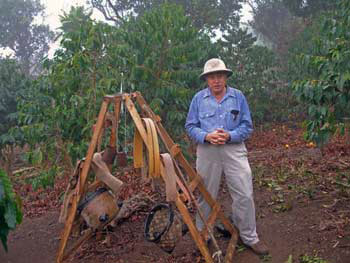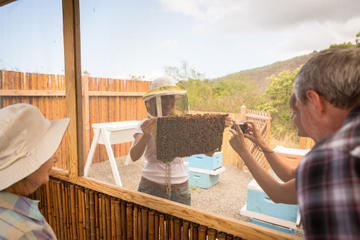
by Troy Herrick
Tropical Hawaii conjures up images of warm temperatures, sandy beaches, palm trees, hula dancers and … freshly-brewed Kona coffee. The latter is certainly one of my fondest memories of the islands. I reserve this treat for weekend and holiday consumption only as I can relax and appreciate the rich, smooth, satisfying flavor that it provides.
Coffee is not native to Hawaii. The British brought the first seeds to the islands in the 19th century and sparked a whole new industry. Now some of the finest gourmet coffee in the world is produced on the South Kona Coast of the Big Island. These 66 square miles of coast constitute an appellation – only coffee grown within these bounds may be legally designated as Kona coffee.
The leeward side of the Mauna Loa volcano creates a special microclimate suitable for coffee production. The sunny mornings and rainy afternoons generate a “coffee cloud” that shades this mountain slope during the late afternoon. Both the coffee cloud and the rich volcanic soil impart a unique taste and aroma to the Arabica coffee beans grown here.
 Many Kona coffee brands are sold in Hawaii. Most of these are blends however. Those wishing to enjoy 100% Kona coffee should read the labels carefully to eliminate the blends. Compare the taste of 100% Kona coffee to the blend just once and you’ll understand why there is simply no comparison between the two.
Many Kona coffee brands are sold in Hawaii. Most of these are blends however. Those wishing to enjoy 100% Kona coffee should read the labels carefully to eliminate the blends. Compare the taste of 100% Kona coffee to the blend just once and you’ll understand why there is simply no comparison between the two.
Approximately 800 coffee plantations operate on the Big Island. Most are no larger than three acres in size. Of these, only four are open to the public: Greenwell Farms, Bayview Coffee Farm, the Ueshima Coffee Company and the Royal Kona Museum and Coffee Mill. Each provides you with an opportunity to taste 100% Kona coffee.
Greenwell Farms provides the best free tour of any commercial coffee farm. Visitors should find that this tour is sufficient for learning all about coffee cultivation and processing. Tour guide George Wakefield-Rae, outlines the processing and equipment used for processing the coffee beans. Steps include: harvesting the ripe coffee cherries, removing the beans from inside the coffee cherries, washing the beans, removing the mucilage coating from the beans, drying the beans on a drying deck or in a tumble dryer, removing a membranous coating from the dried beans, grading the beans and roasting the beans.
 After the tour, visitors are invited to sample light and dark roasted versions of both premium grades known as Extra Fancy and Peaberry. Peaberry beans are an anomaly in that they are plump, single oval beans. Regular coffee beans have two halves with matching flat sides. While this difference seems insignificant, the impact on taste is profound. Peaberry beans have a milder, fruitier taste combined with lower caffeine and higher oil content than regular coffee. I enjoyed the Peaberry so much that I purchased a one pound bag of the lightly roasted beans. The taste was fruity and full-bodied.
After the tour, visitors are invited to sample light and dark roasted versions of both premium grades known as Extra Fancy and Peaberry. Peaberry beans are an anomaly in that they are plump, single oval beans. Regular coffee beans have two halves with matching flat sides. While this difference seems insignificant, the impact on taste is profound. Peaberry beans have a milder, fruitier taste combined with lower caffeine and higher oil content than regular coffee. I enjoyed the Peaberry so much that I purchased a one pound bag of the lightly roasted beans. The taste was fruity and full-bodied.
Bayview Farm produces my long-time favourite Kona coffee. I have been purchasing the dark roasted Extra Fancy coffee beans by mail order since 1999. This day I bought a 5 pound bag. This coffee is tangy with just a hint of spice and great depth of flavor. Savor a cup as you take a moment to admire the view of the bay below. In the distance you see the Captain Cook Monument on the water.
 The Ueshima Coffee Company offers a personalized hands-on roasting tour. Visitors can process their own half-pound bag of coffee beans and then apply a customized label to the product. Those not touring may sample the different Ueshima coffees in the company store.
The Ueshima Coffee Company offers a personalized hands-on roasting tour. Visitors can process their own half-pound bag of coffee beans and then apply a customized label to the product. Those not touring may sample the different Ueshima coffees in the company store.
The Royal Kona Museum and Coffee Mill offers a free self-guided tour and coffee tasting. The museum displays some older coffee processing equipment and details the history of the Kona coffee industry. Visitors can also see operational coffee processing equipment down the hill behind the museum store. While you are there, take the opportunity to walk through the 500 year old lava tube near the drying docks.
Before returning to your car, climb the steps up to the turquoise “tree house” near at the parking lot for a beautiful view of the area. The lush vegetation below the coffee museum slopes gently to the sea over a mile away.
 The nearby Kona Historical Society’s Kona Coffee Living History Farm provides an unusual tour through an early 20th century coffee farm, owned and operated by a traditional Japanese family. A male guide outlines the early farming methods and equipment employed to cultivate and harvest coffee beans. Later, visitors are taken through the farm house by a kimono-clad female tour guide. Here they gain insight into how this family made use of its limited resources. Coffee farming was not a lucrative endeavor so the family was forced to make clothing from used coffee bean sacks. After touring the farm house, take some time to taste some different coffee types.
The nearby Kona Historical Society’s Kona Coffee Living History Farm provides an unusual tour through an early 20th century coffee farm, owned and operated by a traditional Japanese family. A male guide outlines the early farming methods and equipment employed to cultivate and harvest coffee beans. Later, visitors are taken through the farm house by a kimono-clad female tour guide. Here they gain insight into how this family made use of its limited resources. Coffee farming was not a lucrative endeavor so the family was forced to make clothing from used coffee bean sacks. After touring the farm house, take some time to taste some different coffee types.
Getting the Most Out of Your Kona Coffee Purchase
 Those wishing to explore the finer points of coffee tasting would benefit by reviewing the steps in detail at www.wholelattelove.com. Remember the three “S”es: slurp, swirl and swallow.
Those wishing to explore the finer points of coffee tasting would benefit by reviewing the steps in detail at www.wholelattelove.com. Remember the three “S”es: slurp, swirl and swallow.
If you do purchase some Kona coffee, George Wakefield-Rae provides the following advice for proper storage. Freshly roasted coffee should be consumed within the first 3 weeks of purchase so as to enjoy the freshest taste. Coffee beans are best stored in airtight containers with no exposure to light, moisture or freezing temperatures. Freezing the beans breaks down the oils but preserves the caffeine.
What was my first thought upon hearing George’s comment about coffee storage? Just this. With six pounds of coffee beans, I will be drinking as much Kona coffee as I possibly can in the next few weeks – and enjoying every minute of it. Finally, no coffee beans were harmed in preparing this article. However after completion, that is a different story.

Kona Tour: Coffee Plantation, Kealakekua Bay, Kaloko-Honokohau Park and Bee Farm
If You Go:
Kailua-Kona is the best base for your Kona coffee. With careful planning and coordination, all four coffee farms may be visited in a single day as part of a scenic drive south from Kailua-Kona. A rental car is the most practical mode of transportation.
Greenwell Farms
81-6581 Mamalahua Hwy
Kealakekua Hawaii
96750
wwww.greenwellfarms.com
Bayview Coffee Farm
Painted Church Road, approximately 0.4 miles north of the Painted Church
www.bayviewfarmcoffees.com
Ueshima Coffee Company (UCC)
82-5810 Napo’opo’oo Rd in Captain Cook
www.ucc-hawaii.com
Royal Kona Museum and Coffee Mill
83-5427, Mamalahoa Hwy, Captain Cook
Kona Historical Society’s Kona Coffee Living History Farm
82-6199 Mamalahoa Hwy, Kealakekua
Tour: $20 per person
www.konahistorical.org
About the author:
Troy Herrick, a freelance travel writer, has traveled extensively in North America, the Caribbean, Europe and parts of South America. His articles have appeared in Live Life Travel, International Living, Offbeat Travel and Travel Thru History Magazines. He also penned the travel planning e-book entitled ”Turn Your Dream Vacation into Reality: A Game Plan for Seeing the World the Way You Want to See It” – www.thebudgettravelstore.com/page/76972202 based on his own travel experiences over the years. Plan your vacation at his www.thebudgettravelstore.com and www.plan-a-dream-trip.com sites.
Photo Credits:
All photos by Diane Gagnon. A freelance photographer, Diane has traveled extensively in North America, the Caribbean, Europe and parts of South America. Her photographs have accompanied Troy Herrick’s articles in Live Life Travel, Offbeat Travel and Travel Thru History Magazines.


